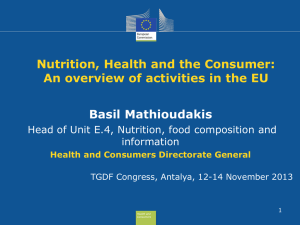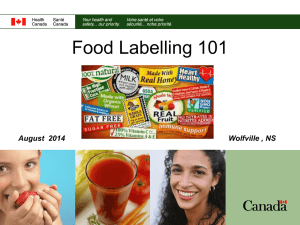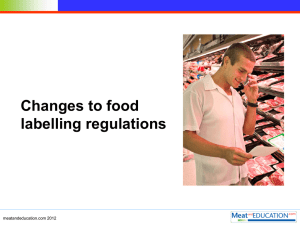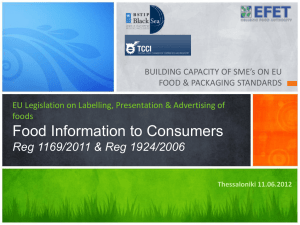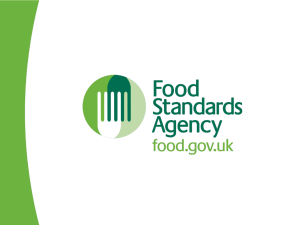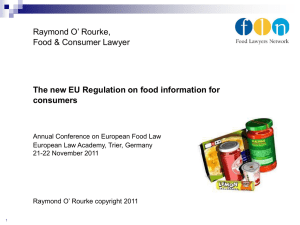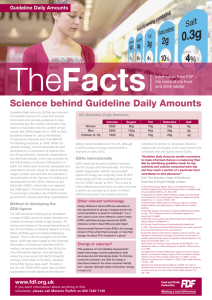REGULATION ON THE PROVISION OF FOOD INFORMATION TO
advertisement
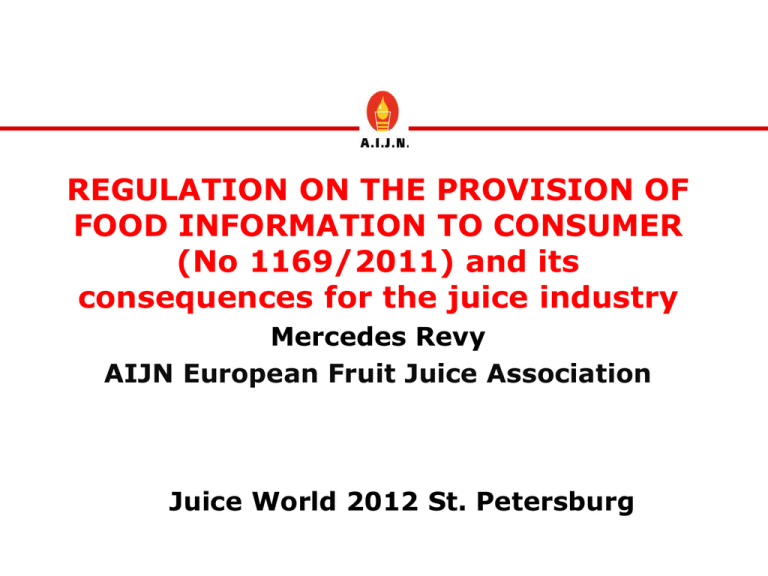
REGULATION ON THE PROVISION OF FOOD INFORMATION TO CONSUMER (No 1169/2011) and its consequences for the juice industry Mercedes Revy AIJN European Fruit Juice Association Juice World 2012 St. Petersburg Context of the review Simplification and modernisation of the legislation Informed choices – safe, healthy diet Protection of the internal market Time line Consultation and review of existing rules on general and nutrition labelling (2003 to 2006) Food labelling better regulation consultation on all aspects of food labelling (March to June 2006) Impact assessment associated with the Commission proposal (December 2006 to July 2007) Commission proposal COM(2008) 40 (Adopted 30 January 2008) First reading position of the European Parliament (Adopted 16 June 2010) First reading of the Council (Common position adopted 21 February 2011) Second reading position of the European Parliament (6 July 2011) Final adoption: 29 September 2011 Commission proposal Issues (1) Simplification General principles Legibility of label Non-prepacked food (stricter rules, allergens requested) Distance selling of food (Mandatory food information to be provided on Internet or catalogues before the purchase is concluded) Commission proposal Issues (2) Origin labelling Nutrition information Alcoholic beverages exempted from: ingredient list and nutrition information Commission to reassess the situation and, if necessary, propose new measures within 3 years of the entry into force of the Regulation Article 9 of Regulation (EU) 1169/2011 List of mandatory particulars Name * List of ingredients Allergens Quantity of ingredients Net quantity * Durability date (after the use by date the product deemed to be unsafe) Special storage conditions Name and address of business Country of origin or place of provenance (not mandatory for fruit juices currently) Instructions for use Alcohol strength (>1.2%) * Nutrition declaration *must be in the same field of vision Improved legibility of labels (1) Article 13. Presentation of mandatory particulars Clear and legible Font size greater or equal to 1.2 mm in the X height If surface area <80 cm2 then the X height must be greater or equal to 0.9mm 200ml = 55 cm2 250ml (slim) = 67.5 cm2 Improved legibility of labels (2) Voluntary information not to be displayed to the detriment of the space available for mandatory information Better information for allergic consumers Information on allergens is required also for non-prepacked foods, including food prepared and served in catering establishments Allergens to be highlighted in the list of ingredients Origin labelling Origin declaration remains voluntary unless its omission could mislead the consumer - NOT MANDATORY FOR FRUIT JUICES New rules to prevent the proliferation of misleading voluntary origin indications (indication of the origin of the primary ingredient when it comes from a different place than the one where the last substantial transformation of the food happened) Partial move to extension of mandatory origin labelling Mandatory origin labelling for: Meat (pig, sheep, goat and poultry) (Implementing rules to be adopted within 2 years) In 3 years report on mandatory origin labelling for: other types of meat meat used as an ingredient (in 2 years) milk and milk used as an ingredient in dairy products unprocessed foods single ingredient products ingredients that are more than 50% of a food Alcoholic beverages (contains more than 1.2% by volume of alcohol Exempted from: ingredient list and nutrition information Commission to reassess the situation and, if necessary, propose new measures within 3 years of the entry into force of the Regulation Mandatory nutrition labelling Nutrition labelling mandatory on the majority of processed food Consumers are interested and want to have such information To encourage healthier dietary choices Incentive to the food industry to reformulate products Nutrition information Mandatory declaration “BIG 7” energy fat saturated fat carbohydrate sugars proteins salt Information related to 100g or 100ml Information in relation to the reference intake (GDAs=guideline daily amount) is made voluntary Voluntary front of pack labelling for: energy, fat, saturates, sugars and salt OR energy alone Reference intake (GDAs=guideline daily amount –voluntary (Source: FDE) Recommended design by FoodDrinkEurope (represents the European food and drink industry): *GDA reference intake of an average adult FOP = FRONT OF PACK information (Source: FDE) Pack contains 2 cans One can (330 ml) contains: Energy Kj/kcal Per 100 g -------% GDA Per portion Sugar %GDA Per portion Fat Saturates Salt %GDA %GDA %GDA Per portion Per portion Per portion *Reference intake of an average adult (8400 KJ/ 2000 Kcal) BOP=Back of pack * reference intake of an average adult , 8400 KJ/ 2000 Kcal (Source: FDE) Nutrition information Per 100g Per Portion % GDA* Energy kJ/kcal kJ/kcal % Fat g g % Of which: saturates g g mono-unsaturates g g polyunsaturates g g g g % % Carbohydrate Of which: Sugars g g Polyols g g Starch g g Fibre g g Protein g g % Salt g g % Vitamins and minerals Annex Annex % Nutrition declaration – Comparison current legislation v. new legislation (Source: FDE) Changes new vs. current Nutrition/ Nutrition labelling to become mandatory. Mandatory information 7 mandatory nutrients instead of “4” or “8”. that must be provided Different order. Voluntary Indication of information that cholesterol no longer possible. may be provided Different order. Order of the Indication of sodium nutrition/mandat and cholesterol no longer possible. ory + voluntary information (expression) Nutrition declaration – Comparison current legislation v. new legislation (Source: FDE) cont. Portion or unit used must be quantified on the label. Specific rules on portions for specific categories of foods. Restriction of the nutrition Repetition of information that may be nutrition put on the front-of-pack. information (and way of expression) Energy on the front-ofpack must always be indicated per 100g/100ml. GDAs Restriction of the use of GDAs to: - the “Big 7” in the ‘nutrient table’ - the repeated nutrients. GDA statement must be provided. The way of expression Voluntary additional forms of expression of nutrition information Allowed but should comply with certain criteria Member States to monitor the use of such voluntary labelling Commission to report to the EP and the Council on use of different forms of presentation 3 years after application of rules Voluntary information Obligation for the Commission to adopt measures related to: Precautionary allergen labelling (“may contain”) Information related to suitability of food for “vegetarians” or “ vegans” Possibility for indication of GDAs for specific population groups Application of the new rules 3 years after the entry into force of the Regulation, it means 13 December 2014 5 years for nutrition labelling, it means 13 December 2016 (nutrition declaration provided on a voluntary basis must comply with the new rules already 3 years (2014)) More information Commission webpage: http://ec.europa.eu/food/food/labellingnutritio n/foodlabelling/proposed_legislation_en.htm http://www.aijn.org/ THANK YOU.

